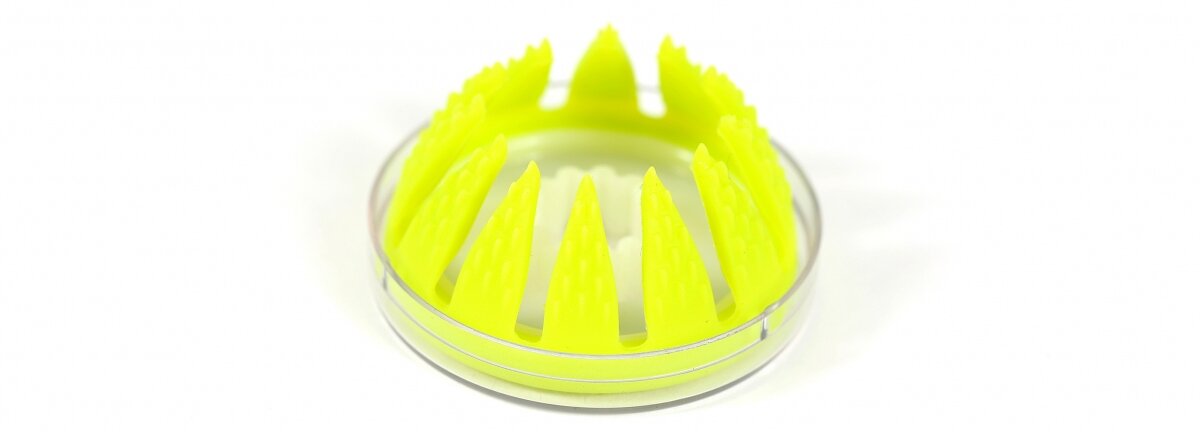TickleTec - Turning a personal challenge into a great idea

Consultant engineer Peter Bailey has been living with diabetes for a number of years. After retiring from designing large-scale industrial projects such as wind turbines and exhibition structures, he decided to devote his time to developing widgets, “clever things that work in unexpected ways”. It was then he realised the one challenge he really wanted to solve was right in front of him: a way of reducing pain when injecting insulin. From this, novel device TickleTec was formed and was awarded funding from our Design Council Spark product innovation fund in 2016 and will be ready for market later this year.
We spoke to Peter to find out more about his journey.
To anyone who isn’t a diabetic, the idea of injecting insulin every day must sound awful. Yet it is wrong to assume that even long-term sufferers don’t feel pain when inserting the needle. “Roughly every ten times you inject insulin you hit a nerve, Peter explains. “You don’t know when it’s going to happen, so the anticipation of every injection can be an anxious experience. In addition, there are other factors that make self injection risky, for example, it is hard to hold the injector pen steady and there is the danger of shearing your skin with the needle, or pushing it in too deep.” While Peter knew from the moment that he was diagnosed that he now faced a lifetime of injections, he also felt that he just had to get on with it. “Diabetes is seen as a bit of a curse, and that creates a resigned mind-set,” he says. “I’d been told this was my life and I just had to put up with it.”
Roughly every ten times you inject insulin you hit a nerve. You don’t know when it’s going to happen, so the anticipation of every injection can be an anxious experience.
Peter Bailey, TickleTec
Luckily, Peter’s engineering brain eventually prompted him to stop putting up with it. He considered the different issues that were affecting his self-injection. “There is just too much variation in the way you can administer the injection, and get it wrong.” He discovered ‘distraction analgesia’, pain relief that works by diverting attention. “It works just like scratching an itch or rubbing an aching joint,” he explains. It didn’t take him long to start prototyping and refining a solution that would fit onto the universal needles that all injector pens use. TickleTec was born.
“It distracts you from the pain,” says Peter, “by saturating local nerves with sensation. But it also pinches together subcutaneous fat, which is much less painful to inject than other tissue. It supports the needle and steadies you so you can’t push it in too far. And last but not least it covers the needle so you can’t see it going in.”
Because Spark was so target driven, it helped me control my urge to refine and refine indefinitely.
Peter Bailey, TickleTec
By the time Peter was accepted onto the Spark programme, TickleTec was a working prototype - however it was made up of 28 different parts. “Because Spark was so target driven, it helped me control my urge to refine and refine indefinitely,” he says. “I simplified my design to two parts by casting the complicated mechanical bits in silicon. I bit the bullet and found a manufacturer. The £15k I was awarded at the end of the Spark Design Camp helped to get the tooling done.”
The programme also made Peter realise that he should stick to doing what he did best – the engineering and design. “There is a place for professional polish across the business, in areas like the strategic marketing, product development, packaging and branding that weren’t my speciality,” he says. “I realised that I had no desire to run the business. I needed to build a team to do that. Because of the skills I learned on Spark I now have a much clearer perspective of what is required.”
Peter is now in the process of putting in place that team. Because the TickleTec is benign and does not penetrate the skin, it has been given a CE Class 1 rating. “If it had been a Class 2 rating the testing would have been prohibitively expensive,” says Peter – which is an important consideration when designing medical devices.
I get emails from people who lives I have improved. Messages from mothers thanking me for transforming the daily struggle to inject their child...I want to do this product justice.
Peter Bailey, TickleTec
While distributors have shown great interest in TickleTec, Peter is continuing to test the product’s desirability with a small number of customers. “I would rather get it on the market in a small way myself so I can understand the audience fully and refine it if needed. Spark made me realise that to be really successful a product needs to make a difference,” says Peter.
“For me the contact with people using TickleTec has been the most satisfying part of the whole process" says Peter. "I get emails from people whose lives I have improved. Messages from mothers thanking me for transforming the daily struggle to inject their child from an hour-long stress filled marathon, to a few easy seconds. I want to do this product justice. Spark has given me the tools and the knowledge to do that.”
Subscribe to our newsletter
Want to keep up with the latest from the Design Council?
